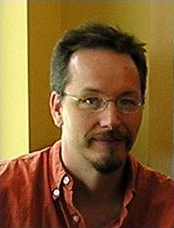Dr. Thomas H. LaBean
The article DNA self-assembly used to mass-produce patterned nanostructures said
“Duke University scientists have used the self-assembling properties of DNA to mass-produce nanometer-scale structures in the shape of a 4x4 grids, on which patterns of molecules can be specified. They said the achievement represents a step toward mass-producing electronic or optical circuits at a scale 10 times smaller than the smallest circuits now being manufactured.Instead of using silicon as the platform for tiny circuits, as is done in the current manufacturing technique of photolithography, the Duke researchers used DNA strands to create grids less than one ten-millionth of a meter square. The smallest features on these square DNA lattices are approximately five to 10 billionths of a meter (nanometers), according to the scientists, compared with about 65 nanometers in silicon circuits created using photolithography.
‘The process we’ve described creates lattices — with patterns we specify — at least tenfold smaller than the best lithography being used right now’, Thom LaBean said. ‘Plus, because we’re using DNA building blocks that assemble themselves, we can simultaneously make trillions of copies of a desired structure.’”
Dr. Thomas H. LaBean received a B.S. with Honors in Biochemistry from Michigan State University in 1985 and a Ph.D. in Biochemistry from University of Pennsylvania in 1993. He is currently engaged in molecular engineering, self-assembly, and bionanoscience at the Computer Science Department at Duke University.
Thom is co-organizer of the NanoScience Seminar Series at Duke University from 2003 to the present, on the Clean Room Design Committee, CEIMAS, at Duke University from 2003 to the present, on the Materials Governance Committee at Duke University from 2001 to the present, on the Editorial Board of the Journal of Biomedical Nanotechnology, and been a Reviewer for the Journal of the American Chemical Society, Proceeding of the National Academy of Science (PNAS), Langmuir, Nanotechnology, Nano Letters, Natural Computing, and The Quarterly Review of Biology.
He coauthored Programmable DNA Self-assemblies for Nanoscale Organization of Ligands and Proteins in Nano Letters, Parallel Molecular Computation of Pair-wise XOR Using DNA “String Tile” Self-Assembly in Journal of the American Chemical Society, Global Similarities in Nucleotide Base Composition among Disparate Functional Classes of Single-Stranded RNA Imply Evolutionary Convergence in RNA, and Libraries of Random-Sequence Polypeptides Produced with High Yield as Carboxy-Terminal Fusions with Ubiquitin in Molecular Diversity.
Thom holds two patents for Methods and Materials for Producing Gene Libraries. He was awarded the rank of Eagle Scout by the Boy Scouts of America in 1979.
